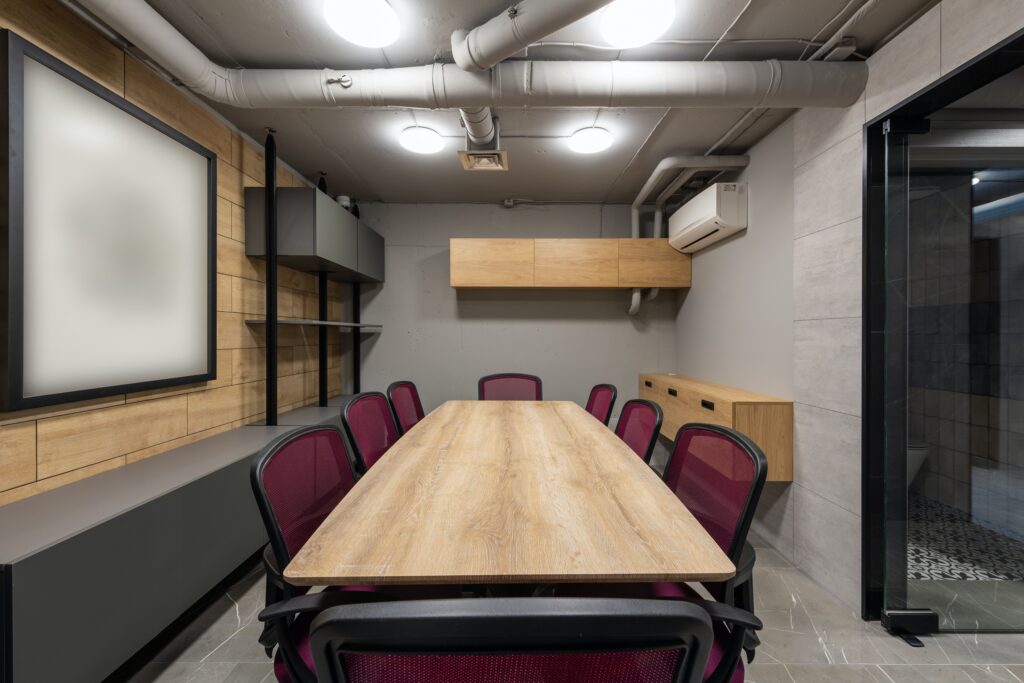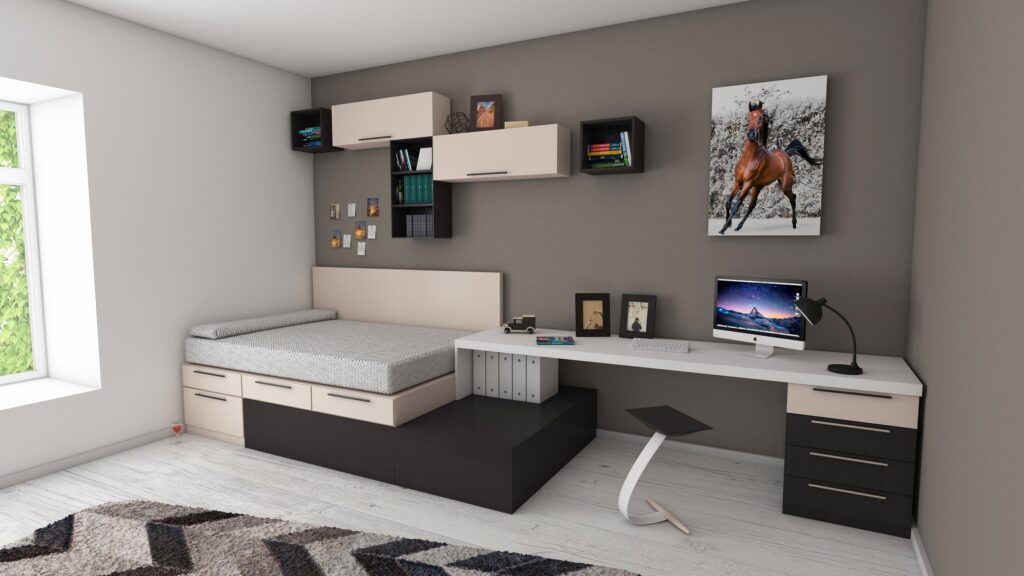Setting up a great home office is essential if you want to work from home. One of the main factors of a well-functioning home office is the size of the office. But what is a good size for a home office?
Well, it depends. It depends on what you need to do in your home office. What kind of work you do, how much space is available, how many people the home office should support, and much more.
I will dive into it all in this article. So keep reading if you want to find the right size for your home office.
Too Long; Didn’t Read:
Start off and determine your home office size based on needs and workflow.
The minimum size is around 70 sq ft, standard size ranges from 100-150 sq ft, and large offices are 200+ sq ft. Which is equal to 6,5 m2, 14 m2, and 18,5 m2.
For small spaces, choose multifunctional furniture and utilize vertical space. In standard-sized offices, prioritize natural lighting, strategic furniture placement, and inspiring decor. Large offices benefit from comfortable, ergonomic furniture, ample storage, and essential equipment.
In all cases, focus on design, layout, and storage solutions for an efficient, comfortable, and productive workspace, regardless of the room size.
Factors you need to consider to find the right size for your home office
When you are setting up your home office, there are plenty of factors to consider. Especially when you are choosing what room to use as a home office. Whatever you choose, you must adapt to the size of the room.
When deciding on the size of your home office, consider the amount of space available to you. If you have a small area to work with like a staircase, a corner desk and chair may be all that can fit comfortably. On the other hand, if you have more room available such as a spare bedroom, garage, living room, or basement, take advantage of it by considering a larger workspace.
You should consider your type of work when determining how much space is needed in your home office. If most of your work is done on a computer, 120 square feet (11 square meters) might be enough for an average-sized workstation.
However, if you need a lot of storage for files and equipment or host client meetings in the space regularly, then opting for at least 10-12 feet (4 meters) in length and width could be necessary for you to be able to do that.
So, size does matter… But it is your need and expectations that dictate just how much space you need in your home office.

Consider the amount of space available
When designing your home office, it’s important to consider the amount of space available. Measuring the room dimensions and considering furniture placement can help you determine what will fit comfortably in the area. Maximizing vertical space with shelves and storage solutions can also free up floor space for movement.
You may have multiple rooms to choose from when setting up your home office. You should set some requirements for the home office and choose the rooms living up to those. By doing that you can decide what is a good size for your home office.
Here are some tips to keep in mind when deciding on the amount of space needed for your home office:
- Keep a minimum clearance around your desk to ensure comfortable movement (at least 3 feet / 1 meter)
- A corner or small area averaging around 120 square feet (11 square meters) may be sufficient for an individual workspace
- If using a computer, aim for at least 10 feet / 3 meters of distance from any windows to reduce glare
- Try it out: See if you can thrive and enjoy working in the room you have in mind for your home office
By taking into account these factors, you’ll know better if the room you have in mind can sustain your home office.
The type of work you do influences your need for space
When it comes to the type of work you do, there are a few things to consider when determining the size of your home office. Firstly, think about the size and number of equipment needed for your work. If you require large or multiple machines, such as printers or scanners, then you may need more space than someone who primarily uses their computer.
Additionally, thinking about noise levels and privacy requirements for specific tasks is important. If you often make phone calls or meetings with clients that require confidentiality, then having enough space to create a designated quiet corner may be necessary. Moreover, if in-person meetings are necessary for your job role, deciding if 10 feet by 12 feet with a private entrance area is required would be beneficial.
At least you would need a dedicated home office for you to make a great impression and make sure that clients see your setup as being professional. It cannot be a corner in your living room, etc.
You furniture needs matter
When designing a home office and deciding on the size of it, it’s important to consider the equipment and furniture needs that you have. Here are some factors to keep in mind:
- Choosing ergonomic furniture is crucial for comfort during long hours at work. Your home office size should at least fit the necessary furniture for you to perform and produce from your home office.
- Determining storage needs based on the amount/type of paperwork or supplies used frequently will help keep your space organized. If you require large storage units or similar, the size of your home office should accommodate this.
- Other uses. If you want to combine your home office with a home gym, nursery, etc., then your room needs to fit the size needed for such a combination.
These aspects are important and they can help you decide on the right room for your home office beside the size of it. Depending on your needs this can help you find a good size for your home office.

How many people should the home office accomodate?
When designing a home office, you need to know how many people are using the office. If there are two or more individuals, deciding on adequate desk space for each person is crucial. The average workspace per person is around 120 square feet (4,5 m2), so a room that measures at least 10-12 feet in length and width would be sufficient for a shared home office for two.
Aside from desks, furnishing additional seating options like couches or chairs can enhance the overall ambiance of the home office while providing extra comfort during extended work hours.
Ultimately, when deciding what size your home office should be, consider both your spatial needs and the number of users that will utilize this area frequently to ensure maximum productivity and efficiency in your working environment.
How to find the ideal size for you home office
When it comes to finding the ideal size for a home office, it’s important to consider your specific needs and workflow. But it becomes so much easier when you have som ground rules to choose from. That is why I have divided requirements based on the minimum, medium, and large-sized home offices for you to decide from.
Finding the minimum size for a home office
When setting up a home office, it’s important to make the most of the available space. Factors such as storage needs and equipment requirements should be considered when determining the absolute minimum size that you can have for your home office.
Here are some factors you should consider in order to find the minimum required size for your home office:
- The number of people who will use the space
- Required equipment (computer, printer, scanner)
- Storage needs (files, books)
- Space for meetings or client visits
- Comfortable working environment
Your needs on the above list dictate what minimum space you require. To put it simply: The less you require, the smaller your home office can be.
The minimum furniture requirements for a small home office include comfortable seating, good lighting, and adequate desk space.
When you are choosing furniture for at minimum sized home office, try to select pieces that serve multiple purposes in order to maximize space in a compact home office:
- Desk with built-in storage
- Adjustable task chair with wheels
- Wall-mounted shelves
- Multifunctional storage cabinets
Finding the medium size for your home office
If you have a little more space available you can add more stuff to your home office. It allows you to feel comfortable and focused, while also allowing you to enjoy other things than just work.
A medium sized home office should be able to cater for all you minimum needs and some. That means that you can demand more from the room and be more critical of the choice you make.
- A larger room should have larger windows. This will allow you to let natural light get in and give you more energy, lessen the burden on your eyesight, and so on.
- Larger furniture such as sofas can be included which makes it possible for you to take breaks and relax when working from home.
- Incorporate plants or other decorative elements that inspire creativity and make you feel better when working from home
- Adding some comfort and “hygge” to your home office becomes possible when you have more space available
Storage solutions are essential and become more attainable in a larger home office. Use vertical storage options such as floating shelves or wall-mounted organizers in a standard-sized space. Consider investing in multi-functional furniture pieces that can double as storage units, like ottomans with hidden compartments or desks with built-in drawers.
All of this should be possible in a medium-sized home office.
Benefiting from a large sized home office
A large-sized home office offers numerous advantages, providing you with a lot of space to design your ideal work environment. With more room at your disposal, you can create distinct zones for various tasks and activities, enhancing both productivity and comfort.
In a spacious home office, you can allocate dedicated areas for different purposes, such as a quiet corner for focused work, a collaboration zone for team meetings or brainstorming sessions, and a relaxation nook to unwind and recharge. By clearly separating these zones, you can maintain a balanced and efficient workflow.
When designing a large home office, consider incorporating ergonomic furniture and equipment, such as a standing desk, an ergonomic office chair, and adjustable monitor arms. These investments can improve your overall well-being by promoting good posture and reducing the risk of physical strain. And you should have the space available, too.
Additionally, a large home office allows you to incorporate elements that boost creativity and motivation. For instance, you can set up an inspiration wall with a whiteboard or corkboard to display ideas, notes, or mood boards. The extra space also enables you to include artwork, a cozy reading area, or even a small exercise station to help you stay active and energized throughout the day.

No matter the size: This is how you maximize the available space
Finding the right size for your home office is one thing. Another is to get the most of the space available. Even the largest home offices can get messy and full of clutter. They will instantly feel smaller.
See below here how you can maximize the space you have available in your home office.
Declutter Your Workspace
Get rid of anything you don’t need or use. Clutter not only makes your workspace look untidy but also affects your productivity and efficiency. Be ruthless in assessing what’s essential and what’s not, then purge whatever doesn’t make the cut.
Organize paperwork and supplies into designated storage areas. This will help you find things more easily when you need them, reduce distractions while you work, and create a more streamlined workflow.
Minimize decorations and personal items to reduce visual clutter. A few carefully chosen pieces can add character to your workspace but too many knick-knacks or personal photos can be distracting. Keep it simple by displaying only the things that motivate or inspire you.
Invest in Space-Saving Furniture
Consider a wall-mounted desk to save floor space, as it can provide the necessary work surface without taking up valuable square footage. Pair this with a chair that can be easily tucked away when not in use and you have an instant space-saving solution. Opt for multi-functional furniture pieces like bookshelves with built-in desks, which help maximize storage and functionality in one piece.
This is especially effective if you have a small home office. Or if your office is meant for multiple purposes.
Investing in space-saving furniture is an excellent way to make the most out of your home office while keeping clutter at bay.
Optimize Your Storage Solutions
As mentioned, you can use the vertical space in your home office by installing shelves or cabinets on the walls. This allows you to keep your desk and floor space free for other uses.
Utilize under-desk storage solutions such as filing cabinets or bins on casters. These can be easily moved around and provide additional storage without taking up valuable floor space.
Invest in organizers like drawer dividers, baskets, and trays to keep everything tidy. This will help you find what you need quickly and efficiently while keeping clutter at bay.
Conclusion: The right size for your home office depends on your needs.
Consider the size of your equipment, the type of work you do, and how much storage you require. When you know that then you know what a good size for a home office suits you.
However, no matter the size of your space, there are always ways to maximize functionality and make the most out of your home office.
By incorporating space-saving furniture, optimizing storage solutions, and creating a functional workstation, you can create a workspace that meets all of your needs while maintaining a comfortable and clutter-free environment.
Keep these tips in mind when designing your home office, and you’ll be well on your way to creating the perfect workspace with just the right size.
My name is Frederik
I am a passionate marketeer who loves the freedom that comes with working from home whenever I choose to do so.
I love getting nerdy with every single detail about making everything related to my home just a tiny bit better.
That is what motivates me to write about home stuff on this blog.
-
Frederik Fisker Waehrenshttps://myeasyhomelife.com/author/frederik-fisker-waehrens/
-
Frederik Fisker Waehrenshttps://myeasyhomelife.com/author/frederik-fisker-waehrens/
-
Frederik Fisker Waehrenshttps://myeasyhomelife.com/author/frederik-fisker-waehrens/
-
Frederik Fisker Waehrenshttps://myeasyhomelife.com/author/frederik-fisker-waehrens/


